Rimac and 26 Suspects Indicted for Corruption, Abuse of Office
ZAGREB, 23 Feb 2022 - The Office for Suppression of Corruption and Organised Crime (USKOK) on Wednesday issued an indictment against former Knin mayor and state secretary Josipa Rimac of the HDZ party and another 26 suspects, including several former office-holders, on corruption and abuse of office charges.
The USKOK investigated this case after a scandal dubbed "wind parks" broke out, but the indictment, which was lodged with Zagreb County Court today, does not refer to the circumstances surrounding the wind parks case, but to alleged irregularities in the allocation of state aid to farmers and grants to businesses, unfair employment and state exams from 2017 to 2020.
Concerning the state aid allocation, former economy assistant minister Ana Mandac is one of the suspects, and her recent testimony resulted in Saturday's arrest of Minister Darko Horvat, who is implicated in the disbursement of grants to ineligible businesses in 2018 when he served as the economy minister.
With regards the favouring of applicants who were expected to pass the state exam to get employment in the state administration, Gabrijela Žalac, former minister for regional development and EU funds, and Ružica Njavro, former Agriculture Ministry chief of staff, are charged with those offences.
The former mayor of Gračac, Nataša Turbić of the Croatian Democratic Union (HDZ), and several business people are suspected of giving bribes to Rimac.
Rimac's lawyer, Lidija Horvat, told Hina that they had not yet officially received a copy of the indictment.
After the wind parks scandal broke out, Rimac was arrested in May 2020, and spent 124 days in pre-trial detention.
For more, check out our dedicated politics section.
Pupovac Causes Uproar in Parliament When Defending His Party Colleague
ZAGREB, 23 Feb 2022 - Several MPs responded heatedly on Wednesday to SDSS leader Milorad Pupovac's accusations about their intention to incite hatred, while he was speaking in defence of Deputy Prime Minister and party colleague, Boris Milošević, who is under investigation for abuse of power.
"There are some people who allegedly advocate justice and legality yet they are doing that in such a way that they incite and instigate hatred and with that, they destroy the very notion of justice and legality while inciting hatred easily leads to inciting violence," said Pupovac of the Independent Democratic Serb Party (SDSS) and added, "those people are not called Boris Milošević."
He underscored however that there are people who will always build a society sensitive to feelings for others, whether that means trying to survive in Dvor, suffering in Okučani or being a casualty of Ovčara. "These people will be found where care is great, plight is difficult and suffering is gruesome. These people have feelings for others and they are called Milošević, Boris Milošević.
Nevertheless, he added, there are people and there always will be those unaware of sensitive society, who are not led by that same feeling for others, for their concerns for tomorrow, their sufferings of today and calamities of yesterday, "whether that be suffering in Donji Lapac, Voćin or in Varivode or Grubori."
Pupovac: Grmoja won't be where there is suffering
Pupovac named Bridge MP Nikola Grmoja, the chairman of the Anti-Corruption Council, as one of those people who would not be where there is suffering nor MP Mirlan Vrkljan who was accused of bribe-taking as a physician.
Pupovac said there are people of all faiths and nations, from all ideological and political groups who use their authority led by social and public morals and their own integrity, no matter what position they hold.
"They do not abuse their power, they serve people regardless of their faith or nation, ideological or political belief", Pupovac said once again referring to Boris Milošević as one of those office-holders.
Grmoja reacted by saying that he has feelings for every Croatian citizen regardless of their ethnicity or party preference.
Grmoja: Subsidies granted to HDZ and SDSS members, friends and neighbours
"You have feelings for MP Dragana Jeckov's (SDSS) neighbours who did not meet the eligibility criteria for subsidies but received them. Croatian veterans did not fight for that sort of Croatia where members of the HDZ and SDSS, close friends and neighbours, are granted subsidies", Grmoja retorted.
"There are people who would arrest Serbs just like they did in 1990 and 1991 and their fate was never learned," Jeckov then told Grmoja.
Grmoja said he would never arrest anyone but would leave that to the competent institutions to arrest corrupt Serbs and even more corrupt Croatians, Croatians in the HDZ and three corrupt Serbs from the ranks of SDSS."
For more, check out our dedicated politics section.
Eight Suspected of Smuggling 119 Migrants and Earning HRK 370,000
ZAGREB, 23 Feb 2022 - Eight people from Croatia and Bosnia and Herzegovina are suspected of smuggling at least 119 Turkish nationals across the border in the wider area of Dubrovnik and Dalmatia, on 21 occasions in 2021 and 2022 and earning HRK 370,000, Dubrovnik police have reported.
Following months of a police investigation, seven Croatian nationals and one from BiH have been suspected of multiple crimes of illegal entry, movement and residence in Croatia and other EU member states.
"The group helped at least 119 Turkish nationals to illegally cross the border and gained HRK 370,000 for that", the police said in a press release.
"Two main perpetrators were remanded in custody while the BiH national had been taken into custody earlier. The remaining five suspects have been reported as accessories", the press release said.
For more news in Croatia, follow TCN's dedicated page.
Zagreb Mayor Inaugurates Sljeme Cable Car
ZAGREB, 23 Feb 2022 - Zagreb Mayor Tomislav Tomašević inaugurated the Sljeme Cable Car on Wednesday, and citizens who have been waiting for the new cable car since 2007 can use it as of tomorrow.
"I am confident that the numerous citizens who will use this cable car will see that the ride is both safe and comfortable," Tomašević said, adding that the main task now is to enhance and increase the attractions and infrastructure on Mount Sljeme, overlooking the capital.
The old cable car was inaugurated in 1963 for the transport of athletes, recreationists and mountaineers, and its route was 4 km, 1 km shorter than the current one. It was one of the longest in Europe and the ride took some 20 minutes. It stopped operating in summer 2007 due to an engine fault, it was also decided that building a new cable car route was going to be more cost-efficient. A ticket cost HRK 11.
The construction of the new cable car was announced by the late mayor Milan Bandić in July 2016. HRK 30 million was earmarked in the city budget for the following year for the construction. A building permit was issued in summer 2018, and works began the following 25 January.
The new cable car was to have been inaugurated on 3 January 2021, but this was delayed until the final papers were ready and for some reconstruction works to be finished in April. However, there was a problem with noise and the final permit was obtained on Monday.
Tomašević said this was "an inherited, megalomaniacal project" worth HRK 537 million without VAT. The city would repay HRK 45 million annually over the next 12 years.
That amount refers to the cable car's capital expense, while an additional amount will be set aside from the city budget to cover 50% of its operating expenses.
"The investment in the cable car will never be returned and its big capacity to transport passengers to Sljeme will never be used to that extent," the mayor said.
The ride lasts 22 minutes. The cable car's maximum capacity is 1,500 passengers per hour, carried in 84 cabins with ten seats each.
The Sljeme Cable Car will operate from 9 am to 5 pm on weekdays and from 8 am to 6 pm on weekends. The first month will be a promotional period and then the cable car will be closed for additional noise-reduction works, after which it will be put into regular operation.
During the promotional month, a one-way ticket will be HRK 30 for adults and HRK 20 for persons aged 15-24 and those over 60, while a return ticket will be HRK 50 for adults and HRK 30 for the other group. Children under 14 and persons will disabilities can use the cable car for free.
(€1 = HRK 7.5)
For more, check out our lifestyle section.
All the Colours of Peristil: New Art Installation Has Split Square Dressed in Gold
February 23rd, 2022 - Named ‘Set the Bird Free, Lock Up the Weapons’, the new art installation at Peristil is only the latest in line of numerous interventions in the famous Split square
The Peristil Square in Split was covered in gold yesterday as part of an art intervention that also features an oversized gun locked in a gigantic cage. As reported by Slobodna Dalmacija, a plaque is displayed on the cage, inscribed with a short message - Imagine.
Created by Swiss-based gallerist Miloš Glavurtić, the artwork is named ‘Set the Bird Free, Lock Up the Weapons’. The pacifist message of the installation is reinforced with the sheet of gold covering the entire surface of the square, possibly alluding to the fact that wars are a lucrative business and are started with financial profit as a driving force.
The art installation is inspired by an earlier work of Croatian conceptual artist Vladimir Dodig Trokut, who in 1991 displayed a gun locked up in a bird cage, and titled the installation ‘The Songbirds’ Song’.
The golden attire is only the latest in line of many art interventions staged at Peristil as a means of protest against various social and political affairs.
Arguably the most famous event of its kind that took place on the square, the legendary Red Peristil was a daring act of a group of Split college students led by artist Pavle Dulčić. In 1968, they painted the entire square red, causing a scandal in the local community.
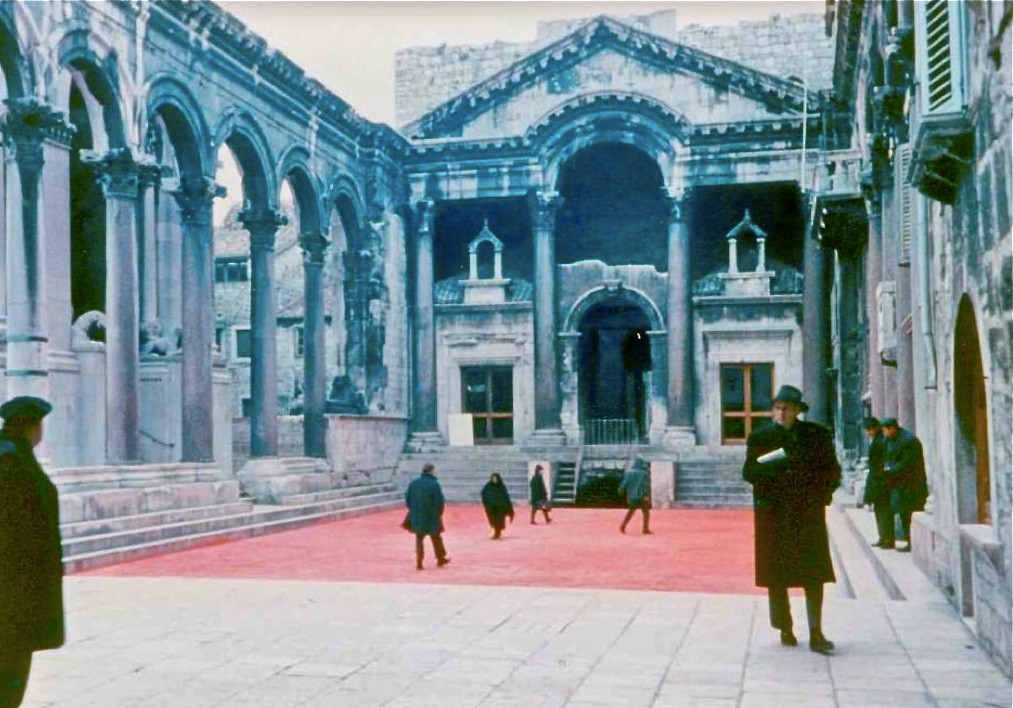 Red Peristil / Source: Petar Grimani, Facebook
Red Peristil / Source: Petar Grimani, Facebook
Seen as an act of vandalism at the time and condemned as a show of disrespect of cultural heritage, the act was later recognised as having artistic quality and is nowadays remembered as one of the first art interventions in these parts.
Twenty years later, Peristil turned green in an intervention staged by multimedia artist Ante Kuštre. Unlike his predecessors, Kuštre didn’t use paint to create his Green Peristil, but covered the square in green panels to raise awareness of environmental issues and bring attention to a deficit of green spaces in the city of Split.
On January 11th 1998, artist Igor Grubić marked the 30th anniversary of the Red Peristil with a work of his own. In the early hours of the morning, Grubić painted the square with a six-metre wide blotch of black.
The artist taped a note on the door of the Tourist Board office, saying: ‘In honour of the Red Peristil group 30 years later. Like a magic mirror, Peristil reflects the state of social consciousness. Black Peristil’.
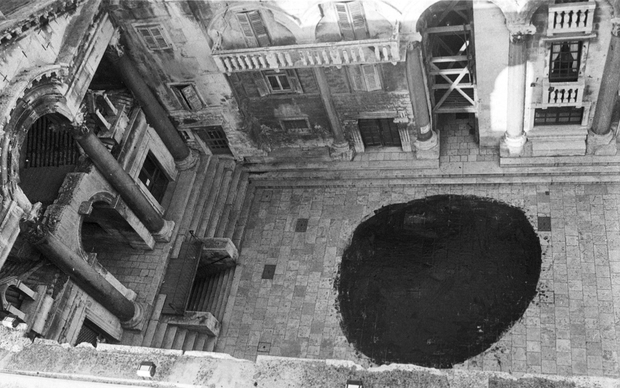 Igor Grubic, Black Peristil, 1998
Igor Grubic, Black Peristil, 1998
At the time, it wasn’t known who was responsible for the act, until Grubić went public months later as the author of the work that was meant to contrast ‘red history’ against ‘the dark present’.
The Peristil of Light was an ambient installation put up on two occasions, on Christmas 1991 and on Christmas 1997, by the painter Alieta Monas. It was a square of light that was placed on the northwest tower of Diocletian's Palace, together with a round piece of red cloth.
The legendary Red Peristil seems to have been a source of inspiration for many, including the artist Petar Grimani who marked the 40th anniversary of the controversial work by launching 40 flares in the main courtyard of Diocletian’s Palace. Named the Flying Peristil by the media, the action had the space lit red for a short period of time.
In 2009, Torcida staged a protest of their own, covering the square with an enormous yellow plastic bag inscribed with the word 'Kodeks' in blue, altogether reminiscent of shopping bags specific to the company Kerum.
The action was meant as a protest against ‘Kerumisation of Hajduk’, i.e. entrepreneur and then Mayor of Split Željko Kerum installing his acquaintances in high positions in Hajduk management.
Dubbed Yellow Peristil by the media, the intervention was condemned by the local authorities, with the mayor stating it wasn’t an art installation but a work of extremists helping the opposition to bring down the city leaders. Torcida in turn stated they were no one's puppet, but only wanted for the leading people of Hajduk to be selected on the basis of merit and expertise.
Next we have the Glass Peristil, a project that took place in the virtual world instead on the Split square. It was designed by art historian and artist Nikola Bojić, who in 2008 anonymously shared a project with the media, signed only as Majorian 458. It was an imaginary architectural project which envisaged construction of a commercial and residential building made of glass on the Peristil square, complete with helipads in the Vestibule and underground garages in the Diocletian’s Cellars, were connected to the Peristyle by escalators.
Even though the project obviously wasn't real and was meant to start a discussion about the need of putting culture before profit when designing public spaces, sensationalist headlines sent the public into a frenzy, and the work was called a ‘terrorist attack on public space, cultural monuments and the historic urban environment’.
And finally, we're back where we started, with gold being the latest colour to adorn the Peristil Square.
Carnival in Eastern Slavonia: February Masquerade Traditions (Part II) - The Food
February 23rd, 2022 - With every traditional festivity comes a reflection of our ancestors' lives, which ties closely to what they ate. This is part two of Carnival in Eastern Slavonia, but this time - the food edition. A look into what Slavonians eat during this traditional event.
Even though it was mentioned in the previous article that the roots of Carnival and Masquerade don’t have anything to do with Christianity and other religions, here in Eastern Slavonia, people decided to connect these traditions with Lent and Easter, which is usually a month and a half later in the Catholic calendar. Food is a significant identifier for every region in Croatia. For instance, Slavonia is popular for its heavy food: pork meat-based food like kulen, its “sister” seka, cracklings (čvarci), sausages, and stews made from beans, cabbage, and many more. Other homemade products are jams made from plums, quinces, apricots, and whatever fruits are available during the summer season. Furthermore, those jams are stored in cold pantries and can last for more than a year if it’s preserved and packed correctly. All mentioned dishes and products are consumed during winter until another set of preparations - always scheduled simultaneously and dated.
In February, these “heavy” dishes, especially dried meat ones like cracklings, are usually used for baked delicacies like čvarnjače, which are made so the leftover cracklings are not thrown away. They are made of salty leavened dough made out of fine flour with grounded cracklings (made out of melted lard) and can be eaten with sour cream or yogurt.
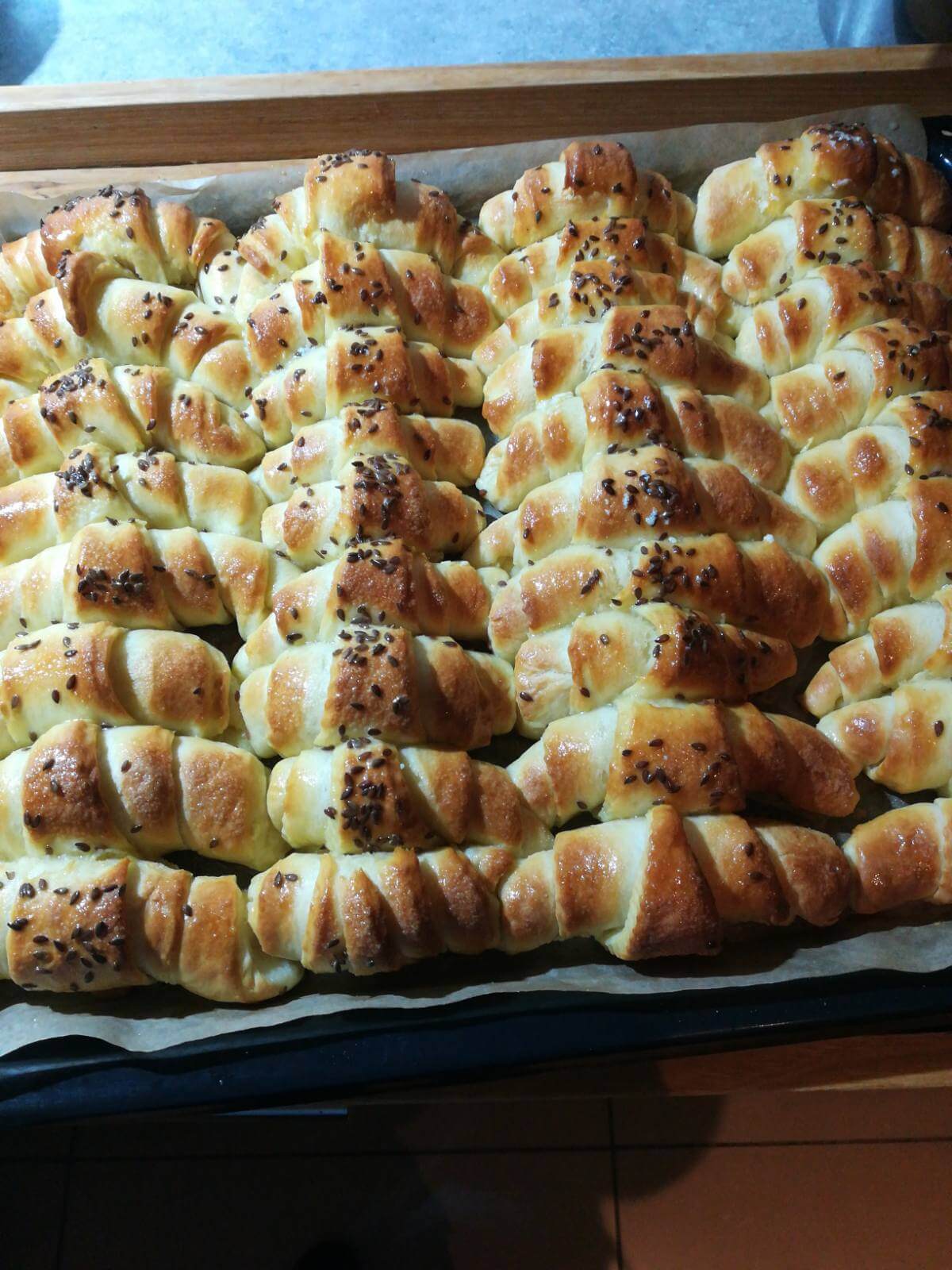
My aunts rolls - "kiflice," Private album
Rolls (kiflice) are also made from salty, leavened dough. Before putting them into the oven, they’re coated with eggs or milk for the colour and sprinkled with sesame or cumin. Since rolls are usually served empty as a snack, Slavonians eat them with a plate of dry meat like kulen, ham, and sausages. It can also be eaten with dairies. My personal favourite is when they are filled with ham and cheese.
Now we get to the good stuff. Sweet delicacies.
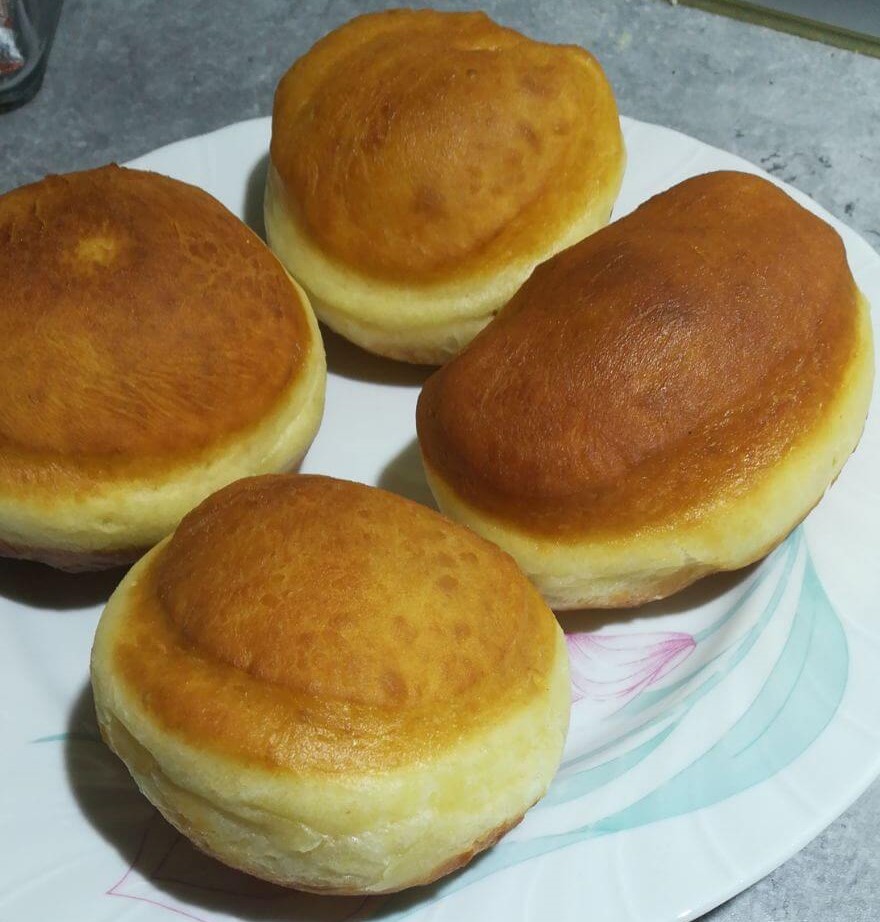
My aunts "krofne" , Private album
During carnival and masquerade in February, the most popular sweet food is donuts (krofne). It is a German sweet dessert made of leavened pastry, baked primarily in hot fat in these parts of the country or oil. In Slavonia, these donuts are called “krofne,” which is a distorted name from the German word “krapfen,” whereas in northern parts like Zagreb and the region of Zagorje, they’re called “krafne”. Interestingly, they’re not usually baked very often, only on special occasions, like “svinjokolja” (pig slaughter), New Year’s, and of course, Carnival. Furthermore, our ancestors believed that “krofne,” while being cooked and rising in volume, symbolizes grace in every aspect of life. Nevertheless, “krofne” are still very prominent in the lives of Slavonians, and they’re usually eaten with powdered sugar and homemade jams. Newer versions of “krofne” come with Nutella and other chocolate spreads, which are very popular with children.
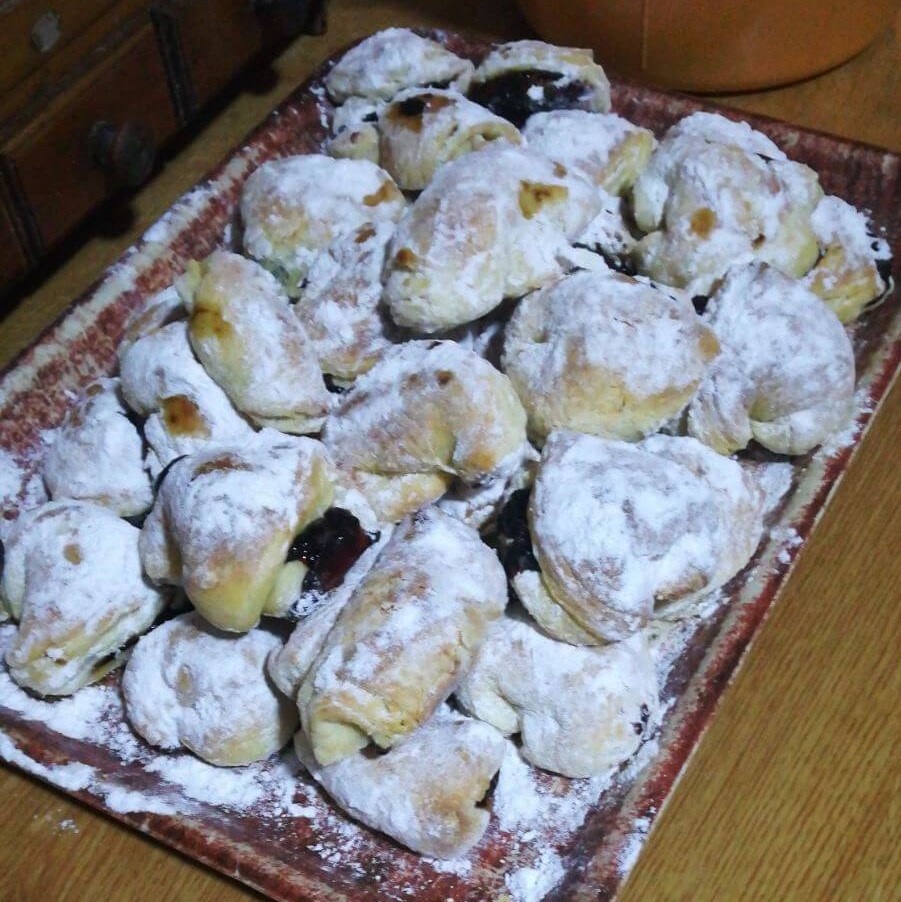
My aunts "salednjaci" - puff pastry dessert with homemade jam, traditional Slavonian delicacy, Private album
This sweet delicacy is a typical traditional Slavonian dessert prepared during “svinjokolja” and the Carnival - “salednjaci.” The name varies in other regions in Croatia; for example, in Zagreb and Zagorje, it is called “salenjaci.” Butter is a usual ingredient for puff pastry, but mothers and grandmothers would use pig lard because there would be a lot of it left after pig slaughter. Also, butter was costly back in the day, so people had to find ways to make those desserts. This delicacy is known as “Croatian croissants with character” and “a cake with thousand leaves” since the puff pastry is folded four times during the process. They’re usually filled with homemade blue plum or an apricot jam. Unfortunately, people have reservations about this dessert because of a misconception that pig fat or lard are not healthy.
On the contrary, it’s healthier than most of the ingredients we consume today. The dessert got lost in the last two decades or so, but it’s slowly coming back through the effort of institutions that preserve tradition and women who started bringing out this dessert on special occasions. Of course, that includes traditional events and festivities in Slavonia during wintertime.
Furthermore, sweet cakes and pastries like “mađarica,” “bijela pita,” “medena pita,” and more are also included on this list. Still, it would take a few more articles to name all traditional Slavonian food.
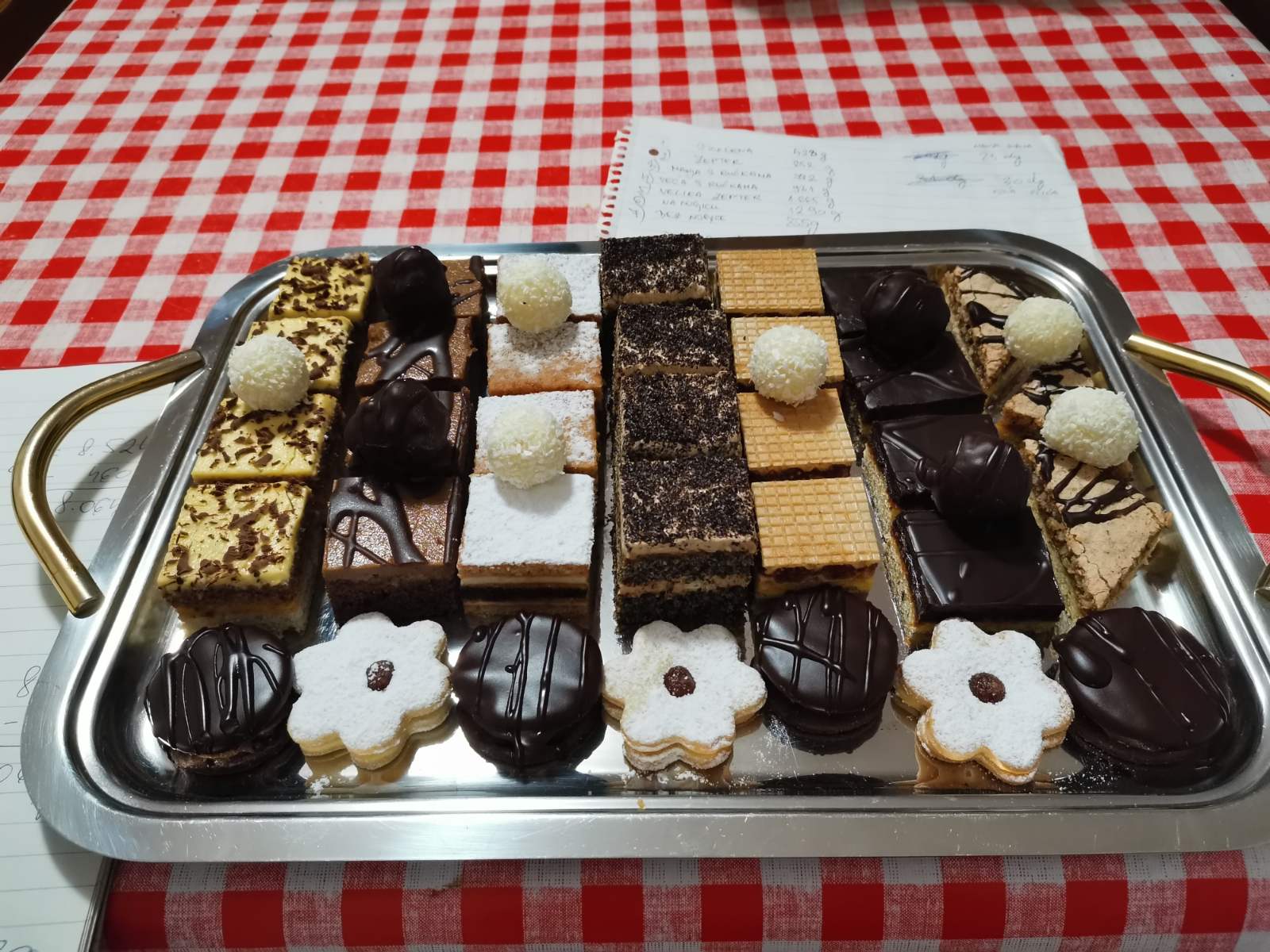
My mother's sweet cakes and pastries, usually made during winter times, Private album
In the end, this article can also be used as an invitation for you to come to Slavonia and participate in the Carnival and other festivities to try these rich delicacies that fed generations and generations of people and still do. There are seven days left until Lent, so hurry up and experience the rich Slavonian life because if there’s one thing Slavonians know how to do, it is eating rich and enjoying life.
For more, check out our lifestyle section.
New Tendencies: The Kinetic Art Movement From Zagreb
February 23, 2022 - An art movement met with worldwide recognition that helped establish Zagreb as a cultural capital. A look at the Kinetic Art movement from Zagreb.
New Tendencies (Nove tendencije) is a series of posters curated by Croatian artist Ivan Picelj, which originally took place at Zagreb’s Museum of Contemporary Art (MSU), in what was then Yugoslavia, from 1961 to 1969. It was an international movement of European artists and theorists who sought after working with new art techniques that differed from abstract expressionism and complex, non-geometric art.
Ivan Picelj is known as one of the most characteristic artists to have come from Croatia and as one of the rare Balkan artists to fully adopt an avant-garde way of thinking and conceptualising art. Aside from leading the New Tendencies are movement, he designed numerous publications, journals, posters, and logos, including the exhibition posters for the MSU, in addition to their exhibition catalogues, and later, the institution’s basic typography and logo.
The art of the New Tendencies movement advocated experimenting with the visual investigation of surfaces, structures, and objects, creating the new concept of methodically planned art, using ideas from mathematics, scientific research and colour theory, and sometimes computers to create images. This method came to be known as “programmed art”, in which basic plastic units were multiplied within a grid, which became an instantly recognisable style of the art movement. Complex, abstract forms were rejected, as simple colour palettes were used and shapes were reduced to simple geometric elements. It was not only visually innovative, but relevant to what was happening in the art world at the time. As Europe was emerging from over a decade of post-war austerity and reconstruction, the artists of that era were reflecting a new age of economic growth and technological progress in their practices.
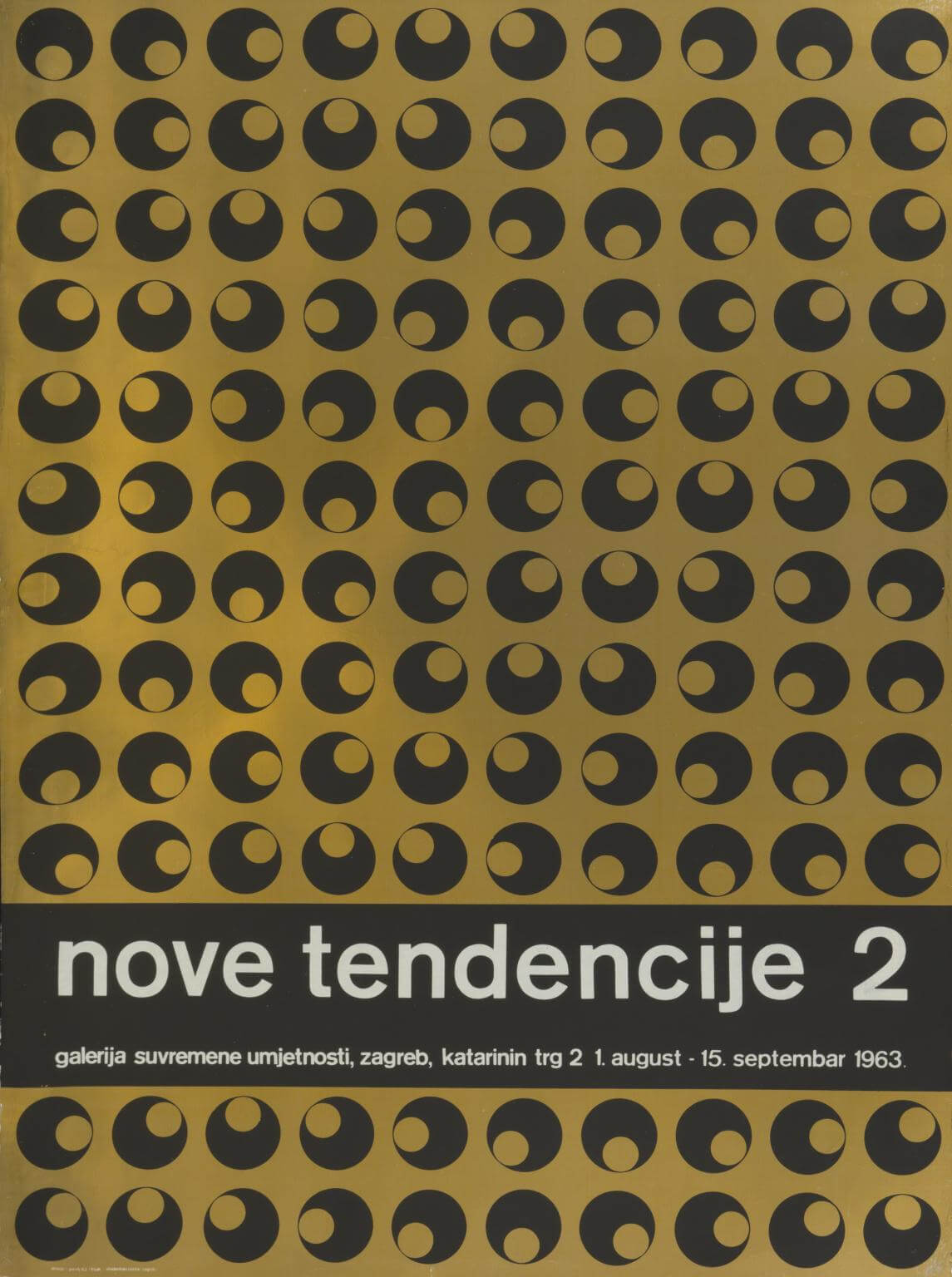
New Tendencies 2 poster by Ivan Picelj, 1963. © Ivan Picelj Estate
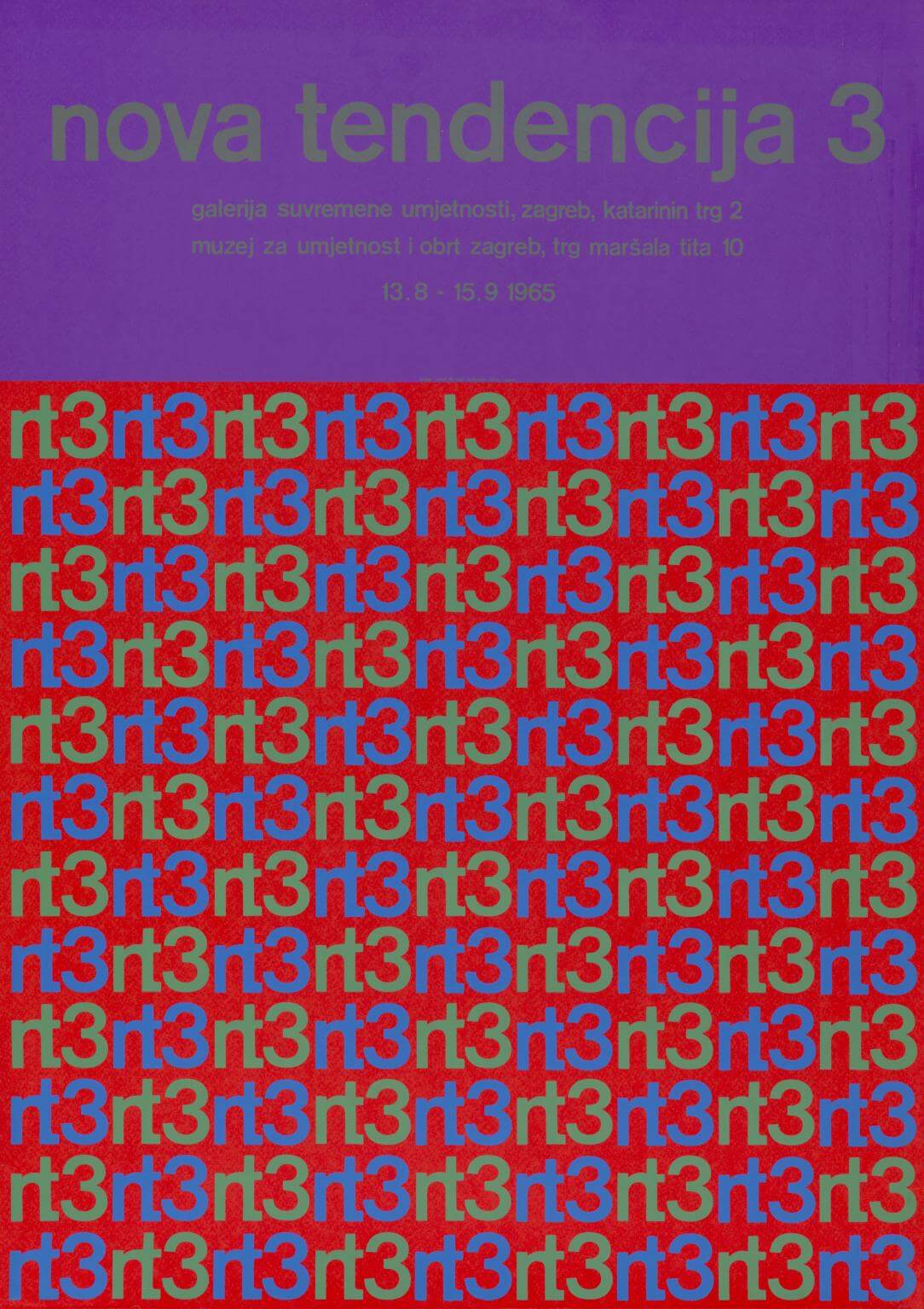
New Tendencies 3 poster by Ivan Picelj, 1965. © Ivan Picelj Estate
The artists of the New Tendencies movement saw the viewer not as a passive spectator but as an active participant, thus encouraging the artist to create work that triggers complex visual sensations, activated by the viewer’s perception of shape and colour. This resulted in some of the movement's most well-known pieces of “moving” kinetic art, created with the use of optical “op” effects - from the scientific understanding behind how these effects are perceived by the viewer.
A key idea behind New Tendencies was how they used the methodological production of their art to commercialise it. Making art that could easily be replicated, they hoped to stop artworks from becoming marketable luxury goods. Coming from the socialist values of its country, the movement emphasised the social role of the artist, and promoted the idea of collective work in an attempt to end the “bourgeois” idea of the artist working as a lone genius. The movement was a collective effort of artists from Austria, France, Germany, Italy and Switzerland, participating alongside Ivan Picelj and fellow Zagreb artist Julije Knifer in the first New Tendencies exhibition in 1961.
The exhibition was such a success that it led to further instalments of the movement, including Tendencies 2 and 3, the latter themed around the movement in Paris. However, Zagreb continued to be the movement’s prime location, functioning as “a kind of unofficial cultural capital of Yugoslavia”, according to Croatian artist, independent curator, and researcher Darko Fritz.
The popularity of New Tendencies triggered an international Op-Art-boom, which was endorsed by an exhibition at the New York MoMA in 1965, titled The Responsive Eye. Now, geometric abstract art is as popular as ever, and the innovative art movement from Zagreb has made its way into academic studies and art galleries all over the world - including an exhibition at London's Tate Modern, running until 26 June 2022.
For more, check out Made in Croatia.
Mitan Marina in Novi Vinodolski Expanding Dry Berth Capacities
February 23rd, 2022 - Mitan Marina in Novi Vinodolski will soon be the first marina in Croatia to have an equal number of dry and wet slips, with a total count of 320 berths
Located in Muroskva Bay in Novi Vinodolski, Mitan Marina currently has 160 berths for boats up to 15 metres in length and can also accommodate mega yachts on the outer side of the front breakwater.
Following last year’s successful sailing season, a second hangar for dry boat storage is about to opened in their dry marina, writes Novi list. Both hangars are heated, have a surface area of 330 square metres each, and can accommodate a total of 160 boats combined.
‘We’re limited when it comes to expansion on the coast because of terrain configuration and the breakwater at the exit from the marina, but we have a good opportunity to expand our dry storage capacities in the industrial zone of Novi Vinodolski, located in the nearby Vinodol Valley’, said Mitan Marina Director Tomislav Salopek.
Mitan Marina is owned by Croatian entrepreneur Vanja Špiljak, who lives in Switzerland. He supports the initiatives of the management headed by director Salopek, as they work to execute their plans for expansion.
After the second hangar for dry berthing is put into use, Mitan Marina will become the first marina in Croatia to have an equal number of wet and dry slips, 160 each, for a total of 320 berths.
‘Apart from the upcoming opening of the second hangar for dry boat storage, we’re planning to build six new apartments in the vicinity of Mitan Marina, on the shore of Muroskva Bay located at the eastern point of entrance to the city. The apartments will have a surface area of 55 square metres each, with a concrete beach and a sunbathing area built in front’, said Salopek.
He confirmed that the other six apartments they already manage had a great occupancy rate, with half their guests being clients of the marina, and the other half tourists who visited Novi Vinodolski without their boats.
Harald Kopitz Children Deaths: State Attorney's Office Files Indictment
February 23, 2022 - The State Attorney's Office has filed an indictment against Harald Kopitz, who killed his three children in Zagreb's Mlinovi last year. He faces up to 50 years in prison.
As reported by Total Croatia News, in September last year Austrian citizen Harald Kopitz was arrested by Croatian police in Zagreb for the murder of his three children.
Harald and his wife were divorced, and she left her children to spend the weekend with their father while she was on a business trip in Dubrovnik. On the night of September 25, following a worrying Facebook status posted by Kopitz that was later reported by his contacts, Zagreb police entered Harald's apartment only to find the dead bodies of the children and their father in critical condition after attempting suicide.

Harald Kopitz, an Austrian citizen residing in Zagreb, was arrested by the police for the alleged murder of his three children, which was later confirmed. In the Facebook status he posted, Kopitz wrote something of a farewell letter, noting that his ex-wife thwarted their current love relationship and that his job situation was not improving. In addition, he stressed that he did not receive the necessary support and that he was ''at the end''. The worrying post caught the attention of his contacts, who reported it to the police. You can read the full story here.
As Index.hr reports today, the State Attorney's Office (DORH) has filed an indictment against Harald Kopitz for the murder of his three children. The Austrian citizen faces up to 50 years in prison.
"Following an investigation, the Zagreb County State's Attorney's Office filed an indictment before the Zagreb County Court on 23 February 2022 against a citizen of the Republic of Austria (1965) for three offenses against life and limb and three aggravated murders under Article 111. items 1 and 2 in conjunction with Article 51 of the Criminal Code.
The indictment charges the defendant that on September 24, 2021, at around 10:00 pm, in Zagreb, in the apartment where he was staying with his three minor children (2013, 2013 and 2016), with a premeditated intention to deprive the children of their lives, took advantage of the children's trust in him as a father and committed the aforementioned criminal offenses to the detriment of the children. In the indictment, the Zagreb County State's Attorney's Office requested that the defendant's pre-trial detention be extended until the end of the criminal proceedings due to the danger of recidivism and particularly serious circumstances of committing this criminal offense (Article 123, paragraph 1, items 3 and 4 of the criminal proceedings)", announced the DORH.
Let us remind you that Kopitz killed his three children in Zagreb's Mlinovi at the end of September, and then tried to kill himself. He was sentenced to pre-trial detention because of the danger of repeating the crime, so as not to influence witnesses and because of the particularly difficult circumstances of the crime he is suspected of.
For more news about Croatia, click here.
Croatia Logs 3,774 New Coronavirus Cases, 37 Deaths
ZAGREB, 23 Feb 2022 - A total of 3,774 new coronavirus cases and 37 COVID-related deaths have been recorded in Croatia in the last 24 hours, the national coronavirus response team reported on Wednesday.
The number of active cases currently stands at 21,446. Among them are 1,555 infected people being treated in hospitals, including 104 on ventilators, while 11,669 persons are self-isolating.
Since 25 February 2020, when the first case was confirmed in Croatia, 1,047,108 people have been registered as having been infected with the new SARS-CoV-2 virus. Of those infected, 14,942 have died and 1,010,720 have recovered, including 1,827 in the last 24 hours.
A total of 4,488,268 people have been tested to date, including 10,185 in the last 24 hours.
By Tuesday, 5,185,303 COVID-19 vaccine doses had been administered, with 56.81% of the total population, or 67.57% of adults, having been vaccinated. A total of 2,305,281 people have received at least one dose and 2,226,540 of them have been fully vaccinated, representing 65.41% of the adult population.
For all you need to know about coronavirus specific to Croatia, make sure to bookmark our dedicated section and select your preferred language if it isn't English.


